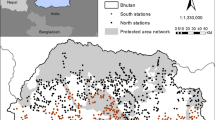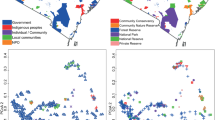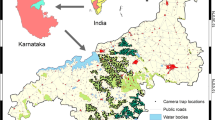Abstract
Protected areas can mediate negative effects of habitat loss and human-related pressures on key ecological groups. However, different protected area categories can vary substantially in their degree of enforcement, which may ensure different levels of effectiveness for biodiversity protection. Because little attempt has been made to quantify this, we investigated the protection effectiveness of different levels of protection (low, intermediate, and high) in maintaining the ecological functions of mammalian species. We assessed this on a selection of five species with varying ecological functions: nine-banded armadillo (insectivore), paca (seed disperser), tayra (omnivore), ocelot (carnivore), and collared peccary (seed predator). Their occupancy probability and the integrity of their ecological functions were estimated and spatialized across landscapes at all protection levels (low, intermediate, and high). In addition, we estimated how many of these species were maintained in each protection status using a minimum of 35% occupancy threshold for each. Our results indicated that higher protection statuses can hold more ecological functions of these mammalian species than areas with lower protection levels. Ocelot and paca heavily relied on areas with higher protection, which can impact the overall ecosystem functioning and ecological services of less protected areas, since these are species performing unique roles in our landscape (mixed-sized prey carnivory and large-sized seed dispersal, respectively). Our study suggests that the degrees of protection can influence the area effectiveness in maintaining certain mammalian species and their ecological functions and ecosystem services. Therefore, management strategies and degree of enforcement should be carefully planned when assigning areas for conservation to ensure the conservation of more sensitive species and preserve more ecological functions.
Similar content being viewed by others
References
Álvarez B (2013) Plataforma QGIS. www.qgis.org. Accessed 10 Jan 2014
Andam KS, Ferraro PJ, Pfaff A, Sanchez-Azofeifa GA, Robalino JA (2008) Measuring the effectiveness of protected area networks in reducing deforestation. PNAS 105(42):16089–16094
Antunes AP, Fewster RM, Venticinque EM, Peres CA, Levi T, Rohe F, Shepard GH (2016) Empty forest or empty rivers? A century of commercial hunting in Amazonia. Sci Adv 2(10):e1600936
Araújo M, Williams PH, Fuller RJ (2002) Dynamics of extinction and the selection of nature reserves. Proc R Soc Lond B 269:1971–1980
Beck-King H, Helversen OV, Beck-King R (1999) Home range, population density, and food resources of Agouti paca (Rodentia: Agoutidae) in Costa Rica: a study using alternative methods. Biotropica 31(4):675–685
Bezerra BM, Barnett AA, Souto A, Jones G (2009) Predation by the tayra on the common marmoset and the pale-throated three-toed sloth. J Ethol 27(1):91–96
Bianchi RDC, Mendes SL, Júnior PDM (2010) Food habits of the ocelot, Leopardus pardalis, in two areas in southeast Brazil. Stud Neotrop Fauna Environ 45(3):111–119
Bianchi RDC, Rosa AF, Gatti A, Mendes SL (2011) Diet of margay, Leopardus wiedii, and jaguarundi, Puma yagouaroundi, (Carnivora: Felidae) in Atlantic rainforest, Brazil. Zoologia 28(1):127–132
Bisbal EF (1986) Food habits of some neotropical carnivores in Venezuela (Mammalia, Carnivora). Mammalia 50(3):329–340
Bodmer RE (1991a) Influence of digestive morphology on resource partitioning in Amazonian ungulates. Oecologia 85:361–365
Bodmer RE (1991b) Strategies of seed dispersal and seed predation in Amazonian ungulates. Biotropica 23:255–261
Boscolo D, Metzger JP (2009) Is bird incidence in Atlantic forest fragments influenced by landscape patterns at multiple scales? Landsc Ecol 24:907–918
Brooks TM, da Fonseca GAB, Rodrigues ASL (2004) Protected areas and species. Conserv Biol 18(3):616–618
Bruner AG, Gullinson RE, Rice RE, Fonseca GAB (2001) Effectiveness of parks in protecting tropical biodiversity. Science 291:125–128
Burnham KP, Anderson D (2002) Model selection and multi-model inference: a practical information–theoretic approach. Springer, New York
Carvalho WD (2011) Mamíferos não voadores da Reserva Biológica da Serra do Japi, São Paulo – avaliação da eficiência e metodologia de captura. Master’s dissertation, Universidade Rural do Rio de Janeiro, Seropédica
Chiarello AG (1999) Effects of fragmentation of the Atlantic Forest on mammal communities in south-eastern Brazil. Biol Conserv 89:71–82
Corrêa HKM, Coutinho PEG, Ferrari SF (2000) Between-year differences in the feeding ecology of highland marmosets (Callithrix aurita and Callithrix flaviceps) in south-eastern Brazil. J Zool 252:421–427
Crawshaw PG (1995) Comparative ecology of ocelots (Felis pardalis) and jaguar (Panthera onca) in a protected subtropical forest in Brazil and Argentina. Ph.D. dissertation, University of Florida, Gainesville
Crooks KR, Soulé ME (1999) Mesopredator release and avifaunal extinctions in a fragmented system. Nature 400(6744):563–566
DeFries R, Hansen A, Turner BL, Reid R, Liu J (2007) Land use change around protected areas: management to balance human needs and ecological function. Ecol Appl 17(4):1031–1038
Dobson A, Lodge D, Alder J, Cumming SG, Keymer J, McGlade J, Mooney H et al (2006) Habitat loss, trophic collapse, and the decline of ecosystem services. Ecology 87(8):1915–1924
Dubost G, Henry O (2006) Comparison of diets of the acouchy, agouti and paca, the three largest terrestrial rodents of French Guianan forests. J Trop Ecol 22:641–651
Emmons LH, Feer F (1997) Neotropical rainforest mammals: a field guide. University of Chicago Press, Chicago
ESRI (2009) ArcGIS. Environmental Systems Research Institute, Redlands
Estes JA, Terborgh J, Brashares JS, Power ME, Berger J, Bond WJ, Carpenter SR et al (2011) Trophic downgrading of planet Earth. Science 333(6040):301–306
Galetti M, Donatti CI, Pires A, Guimarães P Jr, Jordano P (2006) Seed survival and dispersal of an endemic Atlantic forest palm: the combined effects of defaunation and forest fragmentation. Bot J 151(1):141–149
Galetti M, Giacomini HC, Bueno RS, Bernardo CS, Marques RM, Bovendorp RS, Steffler CE et al (2009) Priority areas for the conservation of Atlantic forest large mammals. Biol Conserv 142(6):1229–1241
Galetti M, Guevara R, Côrtes MC, Fadini R, Von Matter S, Leite AB, Labecca F et al (2013) Functional extinction of birds drives rapid evolutionary changes in seed size. Science 340:1086–1090
Gatti A, Bianchi R, Rosa CRX, Mendes SL (2006) Diet of two sympatric carnivores, Cerdocyon thous and Procyon cancrivorus, in a restinga area of Espirito Santo State, Brazil. J Trop Ecol 22(2):227–230
Giné GAF, Duarte JMB, Faria D (2010) Feeding ecology of a selective folivore, the thin-spined porcupine (Chaetomys subspinosus) in the Atlantic forest. J Mamm 91(4):931–941
Hines JE (2006) PRESENCE - Software to estimate patch occupancy and related parameters. USGS-PWRC. www.mbr-pwrc.usgs.gov/software/presence.html. Accessed 2 Dec 2014
Hooper DU, Chapin FS III, Ewel JJ, Hector A, Inchausti P, Lavorel S, Lawton JH et al (2005) Effects of biodiversity on ecosystem functioning: a consensus of current knowledge. Ecol Monogr 75(1):3–35
IUCN (2018) IUCN Red List of Threatened Species. Version 2018.2. www.iucnredlist.org. Accessed 10 Nov 2018
Jiménez-Valverde A, Lobo JM (2007) Threshold criteria for conversion of probability of species presence to either-or-presence-absence. Acta Oecol 31:361–369
Kremen C (2005) Managing ecosystem services: what do we need to know about their ecology? Ecol Lett 8:468–479
Lambeck RJ (1997) Focal species: a multi-species umbrella for nature conservation. Conserv Biol 11:849–856
Licona M, McCleery R, Collier B, Brightsmith DJ, Lopez R (2011) Using ungulate occurrence to evaluate community-based conservation within a biosphere reserve model. Anim Conserv 14:206–214
Loveridge AJ, Wang SW, Frank LG, Seidensticker J (2011) People and felids: conservation of cats and management of conflicts. In: Macdonald DW, Loveridge AJ (eds) Biology and conservation of wild felids. Oxford University Press, New York
Mackenzie DI, Nichols JD, Lachman GB, Droege S, Royle JA, Langtimm CA (2002) Estimating site occupancy rates when detection probabilities are less than one. Ecology 83:2248–2255
Mackenzie DI, Nichols JD, Royle JA, Pollock KH, Bailey LL, Hines JE (2006) Occupancy estimation and modeling. Academic Press, Oxford
Manly BFJ (1997) Randomization and Monte Carlo methods in biology. Chapman and Hall, New York
Massara RL, de Oliveira Paschoal AM, Doherty PF Jr, Hirsch A, Chiarello AG (2015) Ocelot population status in protected Brazilian Atlantic forest. PLoS ONE 10(11):e0141333
Meachen-Samuels J, Van Valkenburgh B (2009) Craniodental indicators of prey size preference in the Felidae. Biol J Linn Soc 96:784–799
Michalski F, Peres CA (2005) Anthropogenic determinants of primate and carnivore local extinctions in a fragmented forest landscape of southern Amazonia. Biol Conserv 124:383–396
Morellato LPC (1992) História natural da Serra do Japi: ecologia e preservação de uma área florestal no sudeste do Brasil. Editora da Unicamp, Campinas
Moreno RS, Kays RW, Samudio R Jr (2006) Competitive release in diets of ocelot (Leopardus pardalis) and puma (Puma concolor) after jaguar (Panthera onca) decline. J Mamm 87(4):808–816
Myers N, Mittermeier RA, Mittermeier CG, Mittermeier CG, Fonseca GAB, Kent J (2000) Biodiversity hotspots for conservation priorities. Nature 403:853–858
Nagendra H (2008) Do parks work? Impact of protected areas on land cover clearing. Ambio 37(5):330–337
Nagy-Reis MB, Setz EZF (2017) Foraging strategies of black-fronted titi monkeys (Callicebus nigrifrons) in relation to food availability in a seasonal tropical forest. Primates 58:149–158
Nagy-Reis MB, Estevo CA, Setz EZF, Ribeiro MC, Chiarello AG, Nichols JD (2017a) Relative importance of anthropogenic landscape characteristics on Neotropical frugivores in a multiple scale perspective. Anim Conserv 20(6):520–531
Nagy-Reis MB, Nichols JD, Chiarello AG, Ribeiro MC, Setz EZF (2017b) Landscape use and co-occurrence patterns of Neotropical spotted cats. PLoS ONE 12(1):e0168441
Neteler M, Bowman MH, Landa M, Metz M (2012) GRASS GIS: a multi-purpose open. Environ Modell Softw 31:124–130
Noss RF, Quigley HB, Hornocker MG, Merril T, Paquet PC (1996) Conservation biology and carnivore conservation in the Rocky Mountains. Conserv Biol 10(4):949–963
Nowell K, Jackson P (1996) Wild cats: status survey and conservation action plan. IUCN/SSC Cat Specialist Group, IUCN, Switzerland
Peres CA, Palacios E (2007) Basin-wide effects of game harvest on vertebrate population densities in Amazonian forest: implications for animal-mediated seed dispersal. Biotropica 39(3):304–315
Phillips A (2004) The history of the international system of protected area management categories. Parks 14(3):4–14
Pimentel DS, Tabarelli M (2004) Seed dispersal of the palm Attalea oleifera in a remnant of Brazilian Atlantic forest. Biotropica 36:74–84
Primack RB (1993) Essentials of conservation biology. Sinauer Associates Inc, Sunderland
R Development Core Tea (2011) R: a language and environment for statistical computing. R Foundation for Statistical Computing. www.R-project.org. Accessed 2 Oct 2014
Redford KH (1992) The empty forest. Bioscience 42:412–422
Ribeiro MC, Metzger JP, Martensen AC, Ponzoni FJ, Hirota MM (2009) The Brazilian Atlantic forest: how much is left, and how is the remaining forest distributed? Implications for conservation. Biol Conserv 142:1141–1153
Rodrigues TF, Chiarello AG (2018) Native forests within and outside protected areas are key for nine-banded armadillo (Dasypus novemcinctus) occupancy in agricultural landscapes. Agric Ecosyst Environ 266:133–141
Rodrigues AS, Andelman SJ, Bakarr MI, Boitani L, Brooks TM, Cowling RM, Fishpool LDC et al (2004) Effectiveness of the global protected area network in representing species diversity. Nature 428(8):640–643
Rondinini C, Wilson KA, Boitani L, Grantham H, Possingham HP (2006) Tradeoffs of different types of species occurrence data for use in systematic conservation planning. Ecol Lett 9:1136–1145
Royle A, Nichols JD, Kéry M (2005) Modelling occurrence and abundance of species when detection is imperfect. Oikos 110:353–359
Santori RT, de Moraes DA, Cerqueira R (1995) Diet composition of Metachirus nudicaudatus and Didelphis aurita (Marsupialia, Didelphoidea) in southeastern Brazil. Mammalia 59(4):511–516
Silva-Pereira JE, Moro-Rios RF, Bilski DR, Passos FC (2011) Diets of three sympatric Neotropical small cats: Food niche overlap and interspecies differences in prey consumption. Mamm Biol 76(3):308–312
SMPMA - Secretaria Municipal de Planejamento e Meio Ambiente (2008) Plano de manejo - Reserva Biológica Municipal da Serra do Japi-Jundiaí-SP. Prefeitura de Jundiaí, Jundiaí
Steenweg R, Hebblewhite M, Whittington J, Lukacs P, McKelvey K (2018) Sampling scales define occupancy and underlying occupancy–abundance relationships in animals. Ecology 99(1):172–183
Stoner C, Caro T, Mduma S, Mlingwa C, Sabuni G, Borner M (2007) Assessment of effectiveness of protection strategies in Tanzania based on a decade of survey data for large herbivores. Conserv Biol 21(3):635–646
Sunquist M, Sunquist F (2002) Wild cats of the world. The University of Chicago Press, London
TEAM Network (2011) Terrestrial Vertebrate protocol implementation manual, version 3.1. Arlington: tropical ecology, assessment and monitoring network, conservation international. www.teamnetwork.org/protocol/terrestrial-vertebrate-camera-trapping-monitoring-protocol. Accessed 5 Feb 2012
Terborgh J, Lopez L, Nunez P, Rao M, Shahabuddin G, Orihuela G, Riveros M et al (2001) Ecological meltdown in predator-free forest fragments. Science 294(5548):1923–1926
Vaz VC, Santori RT, Jansen AM, Delciellos AC, D’Andrea PS (2012) Notes on food habits of armadillos (Cingulata, Dasypodidae) and anteaters (Pilosa, Myrmecophagidae) at Serra da Capivara National Park (Piauí State, Brazil). Edentata 13:84–89
Wright SJ (2003) The myriad consequences of hunting for vertebrates and plants in tropical forests. Perspect Plant Ecol Evol Syst 6:73–86
Wright SJ, Zeballos H, Domínguez I, Gallardo MM, Moreno MC, Ibáñez R (2000) Poachers alter mammal abundance, seed dispersal, and seed predation in a Neotropical forest. Conserv Biol 14:227–239
Acknowledgements
We are thankful to Jundiaí City Hall and all private owners for permission to conduct this project at Serra do Japi, and to Coordination for the Improvement of Higher Education Personnel (CAPES), São Paulo Research Foundation (FAPESP; Grant 2013/07162-6), and Idea Wild for their financial and equipment support. We are also grateful to J. E. Hines and J. D. Nichols for assisting in our data analysis; V. H. Iwakami, C. A. Estevo, Traldi family, and Benê for assisting during data collection. The Brazilian Science Council (CNPq) provided a research Grant to AGC (process 305902/2014-8). MCR has been continuously supported by Grants and scholarships from CNPq (process 303101/2017-2) and FAPESP (Grant 2013/50421-2). Megan King, a native English speaker from British Columbia, CA, proofread the manuscript.
Author information
Authors and Affiliations
Corresponding author
Additional information
Communicated by Iain James Gordon.
Publisher's Note
Springer Nature remains neutral with regard to jurisdictional claims in published maps and institutional affiliations.
This article belongs to the Topical Collection: Biodiversity protection and reserves.
Electronic supplementary material
Below is the link to the electronic supplementary material.
Rights and permissions
About this article
Cite this article
Nagy-Reis, M.B., Ribeiro, M.C., Setz, E.Z.F. et al. The key role of protection status in safeguarding the ecological functions of some Neotropical mammals. Biodivers Conserv 28, 2599–2613 (2019). https://doi.org/10.1007/s10531-019-01783-y
Received:
Revised:
Accepted:
Published:
Issue Date:
DOI: https://doi.org/10.1007/s10531-019-01783-y









